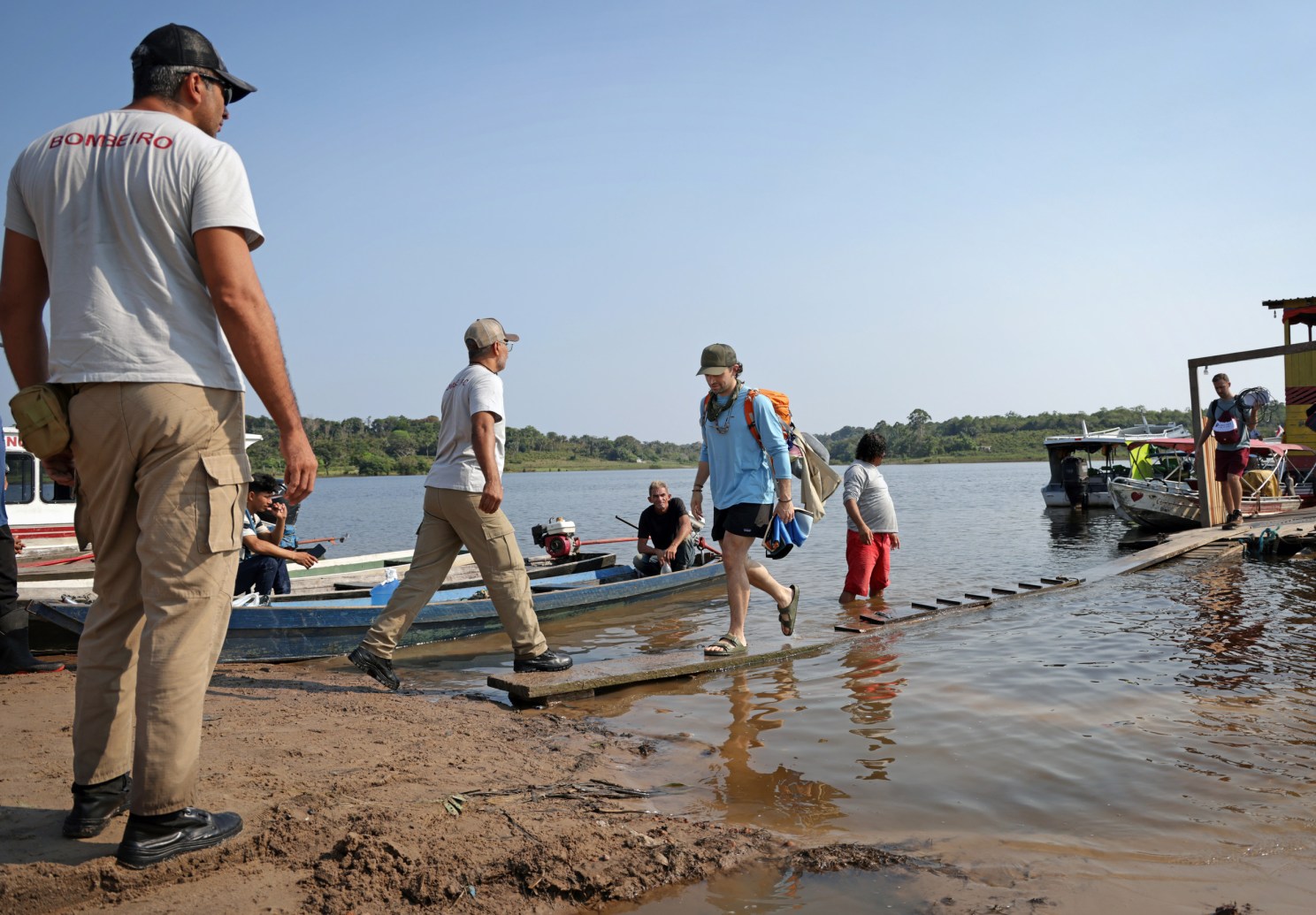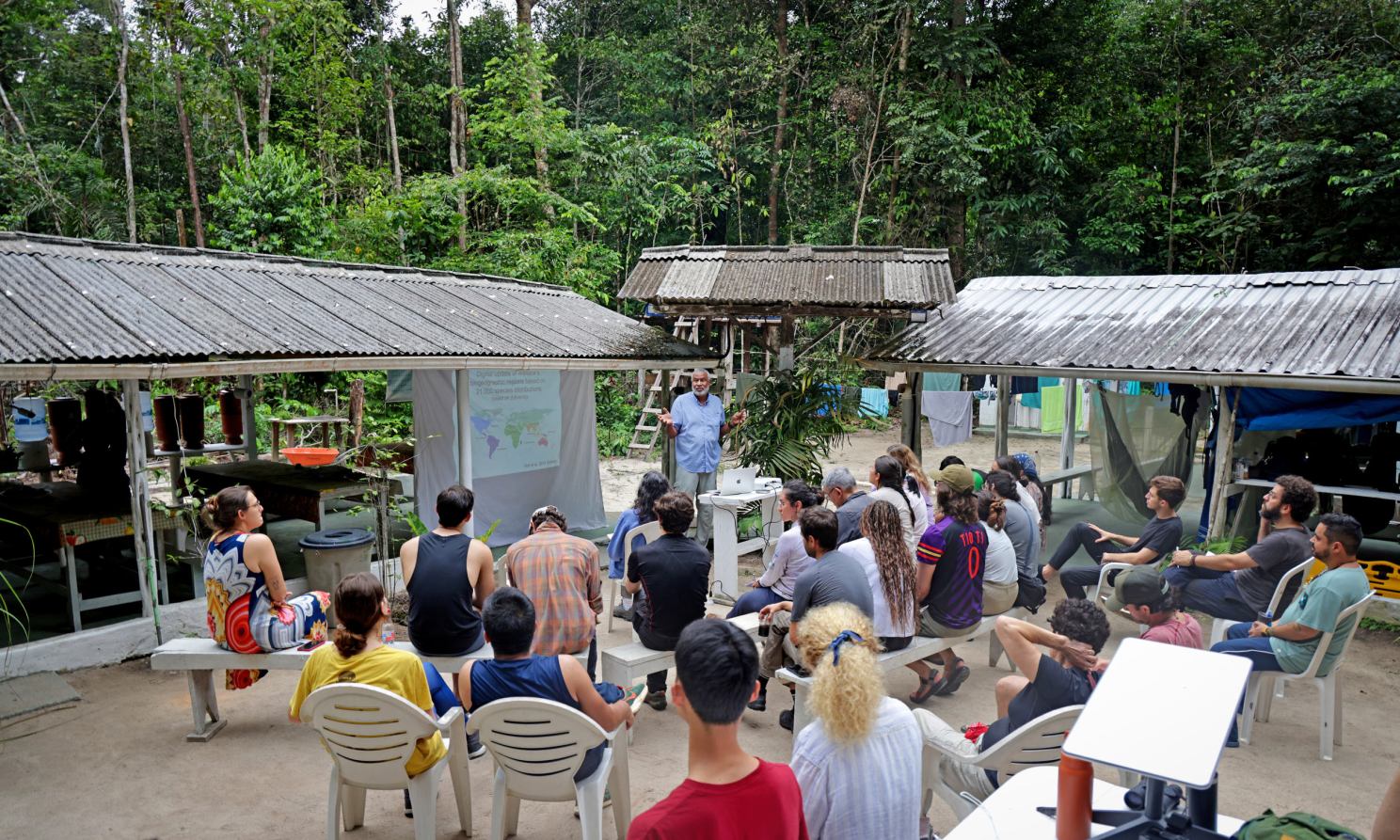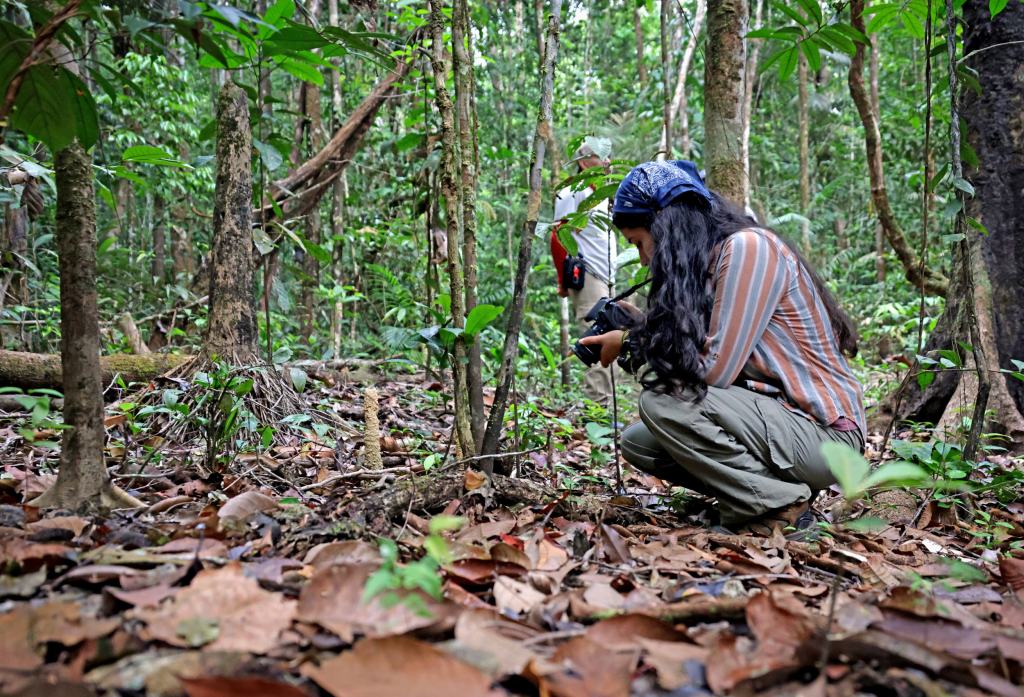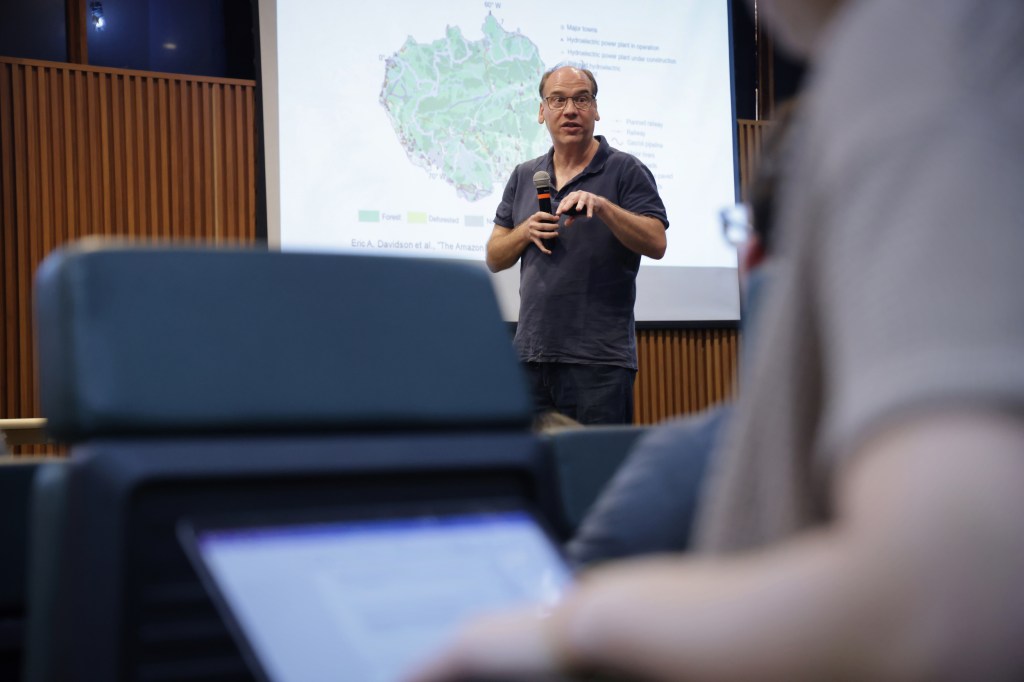MANAUS, BRAZIL — Students were hours into exploring the Amazon rainforest when their guide caught the glint of something special.
Thiago G. Carvalho, a staff zoologist with Museu da Amazônia (Musa), removed the caterpillar-like creature from a tree branch and raised it on the pads of his fingertips like an offering. He wanted the group to appreciate this fuzzy little insect patterned with greens and golds.
“We have to learn as biologists to see beauty in all kinds of life,” Carvalho said, noting that he couldn’t be sure of the exact genus in an area so rich with biodiversity. “And this little guy is beautiful.”
The find was one of thousands during a recent teaching and research intensive organized by the David Rockefeller Center for Latin American Studies (DRCLAS). The Harvard Amazon Rainforest Immersion explored the region’s intricate ecosystems as well as urgent threats to its economic security, environment, and public health. A primary goal was expanding partnerships with scientists and other innovators who work in a place of central importance to the global climate. But the 10-day course also served a more fundamental purpose.
“Most Brazilians don’t know what the Amazon is,” said Marcia Castro, the Andelot Professor of Demography at the Harvard T.H. Chan School of Public Health and chair of the DRCLAS Brazil Studies Program. “And for those outside Brazil, it’s even bigger … the information they get is filtered. Sometimes it’s biased. Other times they think they have the perfect solution to solve all the Amazon’s problems.”
Speaking at the immersion’s kickoff in this city of 2.3 million, Castro pressed the students, professors, and young academics to bring a different mindset. “Be curious, listen — don’t judge,” she said.
A few hours later, the group toured Musa, a 250-acre reserve at the city’s edge veined with outdoor exhibits and walking trails. As Carvalho plucked dragonfly larvae and other life forms from the forest, the visitors grew more observant, focused. The Brazilian state of Amazonas, where invertebrates account for the majority of biodiversity, proved full of inviting detail.
Soon a trio of students were staring at a boa constrictor in a tank. Another set of visitors crouched to inspect a young tarantula Carvalho spotted. Others paused over the line of leaf-cutter ants soldiering by.
Christopher Hilgemberg leads water quality testing demonstrations on the Rio Uatumã.

Nicholas Arisco exits a boat along the Uatumã River. “I didn’t expect the rivers to be this big,” he said.

Professor Naomi Oreskes talks to the group as the boat travels the Rio Uatumã.

As a first-time visitor to the Amazon, Professor Scott Edwards lectures at Camp 41.
“I love studying ant colonies! They’re so interesting!” cried David Caleb Brown ’25, an applied math concentrator from Alabama currently investigating how high-altitude remote sensing balloons can be used to fight deforestation in the Amazon.
Co-sponsored by the Salata Institute for Climate and Sustainability, the multidisciplinary experience was organized by the DRCLAS Brazil Office with help from Amazonas State University (UEA) and Academia Amazônia Ensina. Twenty-one students and academics represented the College and four Harvard graduate Schools as well as universities across South America in fields that included the sciences, romance languages, public policy, and law.
All are engaged in research that impacts the Amazon, from fighting the rise of illegal gold mining to promoting sustainable agriculture and limiting government corruption. But for many, the immersion marked their first visit to the world’s largest tropical rainforest.
“Being here and seeing everything around me is a childhood dream come true,” shared Dariana González-Aguilar ’25, an integrative biology concentrator with roots in North Carolina and central Mexico who hopes to work on conservation in Brazil.
“The whole idea is to give people a chance to get to know this extremely important biome,” said Castro, a Rio de Janeiro native who has studied malaria in the region since 1999 and teaches a three-week course in Brazil every January (the 2024 iteration was set in the Amazon). “I hope in the end everyone goes back to Harvard, or goes back to their homes in Brazil, transformed but above all inspired to continue their work.”

Deep dive into the Amazon basin
For three days, participants immersed themselves in the vast topaz of the Amazon basin, home to nearly 20 percent of the world’s river waters. Boarding the Victória Amazônica with the group was Scot Martin, the Gordon McKay Professor of Environmental Science and Engineering and Professor of Earth and Planetary Sciences at the John A. Paulson School of Engineering and Applied Sciences, who has deep ties to the region known as Amazonia.
Martin first visited in 2007 and now travels to Manaus regularly. He has picked up Portuguese, started following World Cup soccer, and partners with UEA researchers on various projects. “The Amazon is a place that inspires in every regard,” he said as the boat traveled a quiet stretch of the Rio Uatumã.

In a lecture, Martin charted the inner workings of the Amazon watershed, with its famous system of “flying rivers.” Trees act as the rainforest’s “water pumps,” he explained, taking in H2O and gradually releasing it skyward via a process called evapotranspiration. That’s why deforestation means lower river levels across the Amazon basin and less rainfall far beyond.
“I had imagined the deforestation was driven by cattle ranching,” said Chun-Yu Su ’27, a sophomore from Taiwan concentrating in integrative biology. “But Professor Martin pointed out there’s heterogeneity in terms of geography, because the Amazon is about two-thirds the size of the continental U.S.” In some areas, the land was deforested for large-scale ranching and soybean fields. In others, it was driven by smaller-scale agriculture, including subsistence farming.
Consequences include extreme drought, increased wildfire risk, and crop loss in the Amazon and its neighboring “breadbasket” regions, Martin said. Future implications could include water rationing and power shortages across Brazil, a nation heavily dependent on hydroelectric. “And then you have one that was big last year,” he added, noting that water levels would be even lower in the last months of 2024. “The only way to get to most towns in the State of Amazonas is by river navigation or air. When the drought hit, these communities were really cut off.”
Martin also outlined one of his projects with UEA collaborators, this one involving a team that monitors water quality in area rivers. Specifically, the team is investigating the source of high mercury levels across the Amazon basin, where communities are at heightened risk of exposure because residents consume so much fresh-water fish. Co-leading this research is Martin’s SEAS colleague Elsie Sunderland, the Fred Kavli Professor of Environmental Chemistry and a global expert on mercury contamination.
One culprit is illegal gold mining, on the rise in Amazonia since the early 2000s. It’s a “messy business,” Martin explained, with mercury used to isolate gold from river sediment. The mercury-gold amalgam is then roasted, releasing toxic fumes into the atmosphere while leaving behind the prized metal. In parts of the northern Amazon where illegal mining is highly prevalent, widespread mercury poisoning has been found in some Indigenous communities, he said.
On a still evening, a team from UEA demonstrated how their partnership with Martin works. They ferried the group in a fleet of small motorboats across a remote stretch of the Rio Uatumã, speeding past cow pastures before settling near the shoreline.
“I do a lot of mapping of the Amazon,” remarked Nicholas Arisco, M.S. ’18, Ph.D. ’23, a postdoctoral fellow from Connecticut studying health and populations at the Chan School. “I didn’t expect the rivers to be this big.”
Collected samples were transferred to the floating laboratory UEA recently built to test water for contaminants such as bacteria and phosphorus. Analyzing for mercury is done in Sunderland’s lab at Harvard.
Back on Victória Amazônica, UEA biotechnology Professor Rafael Lopes e Oliveira underscored the logistical challenges of performing this work. The Amazon basin vacillates between drought and downpour, a challenge to researchers as well as those residing in rural communities, he explained through a DRCLAS translator. If you want to study biochemistry or microbiology, he said, you need to understand culture and interpersonal relationships, because access depends on local communities.
‘Social construction of ignorance’
Joining the immersion for their first visits to the Amazon were Naomi Oreskes, Henry Charles Lea Professor of the History of Science, and Scott V. Edwards ’86, Alexander Agassiz Professor of Zoology and chair of the Department of Organismic and Evolutionary Biology as well as curator of ornithology in the Museum of Comparative Zoology.
“I’m part of a small group of scientists talking about a field called agnotology, or studying the social construction of ignorance,” Oreskes explained one afternoon, speaking to the group sitting cross-legged in the boat’s air-conditioned dining room.
Her insights on “market fundamentalism” — the idea that free markets can solve all of society’s problems — proved especially pertinent to Amazonia. Reviewing ideas explored in 2010’s “Merchants of Doubt” and 2023’s “The Big Myth,” Oreskes underscored the “negative externalities” of business ventures that drive climate change — essentially, taking profits from activities that damage the environment but leaving costs of cleanup and environmental rehabilitation to communities.
“We’ve had many lectures on deforestation and science,” said Peruvian Lucero Beatriz Reymundo Dámaso, a master’s candidate in anthropology at Brazil’s Federal University of Santa Catarina. “I appreciate that Naomi came in and said, ‘Wait — there’s also this cultural component.’”
The river trek featured several stops in the Uatumã Sustainable Development Reserve, where residents have banded together to fight exploitive development. André Vianna from the Manaus-based NGO Idesam outlined the initiative’s purpose of bridging conservation goals with marketing and supply chain supports for small, rural producers. Today, the area is zoned by the state of Amazonas for ventures that conserve the rainforest.
Furnituremaker Elizângela Cavalcante introduced the group to the São Francisco das Chagas do Caribi community of artisans, planters, and “extractivistas” (or those who harvest the rainforest’s abundance sustainably). She walked participants past the community’s tiny gift shop, where açaí beaded jewelry and elegant wooden bowls were available for purchase, and charmed visitors with stories of marriage, work, and family life.
“For me, it was remarkable to learn how women are leading business development and taking care of sustainability,” said Vinícius Prado, Ph.D. ’27, a former program officer for the United Nations Population Fund from Belo Horizonte, Brazil, who is studying population health sciences at the Chan School. “They already are overburdened with their work on caregiving added to their economic activities … and yet they are concerned about the environment and creating a better world for future generations.”
The group also met with José Monteiro, keeper of the Pousada Mirante do Uatumã inn and a 30-acre agroforestry plot launched in 2008 with support from Idesam. Monteiro had previously deforested his land in favor of cattle ranching. Today, the family property yields shade as well as farm-fresh eggs and Brazil nuts.
“It was really interesting because I asked him: ‘How are you doing? Are you earning a better living?’” Oreskes said. “He said they weren’t; it’s about a wash. But the life is so much better.”
It was a reminder for Oreskes that green transitions seldom trigger immediate financial rewards. “This is true even in the United States, with putting in solar panels or installing better windows on your house,” Oreskes said. “Often there’s an upfront investment, but you get it back in the long run.”
The mixed blessing of roads
Heat and humidity challenge those conducting research in Amazonia, but the lack of reliable roads serves up additional impediments. From the Victória Amazônica, traveling to the next stop required one hour on a speed boat and another four hours by bus. At a rural meeting point, groups of three or four transferred to heavy-duty trucks, some of the only vehicles capable of navigating the final stretch of watery and deeply rutted roadway.
Located 70 miles north of Manaus, Camp 41 is a reservation and research station established in 1979 by the late Thomas E. Lovejoy III, a George Mason University ecologist and Amazon preservationist. It was part of an initiative to protect pristine rainforest fragments as roads, developers, and cattle ranchers moved in. The site has since served as a base for scientists tracking diverse species of birds and butterflies as well as monkeys.

Welcoming the group there this summer was Massachusetts-born ornithologist Mario Cohn-Haft, a member of the ecology faculty at the Brazilian National Institute for Amazon Research (INPA) in Manaus and a top authority on avian life in the Amazon. He traced his own involvement with the camp to a 1987 bird-monitoring internship.
“I ended up moving my whole life down here,” Cohn-Haft said. “I married a Brazilian. I conduct my life in Portuguese, teach graduate students in Portuguese. And it’s all thanks to this project.”
A series of tin-roof pavilions where tight rows of hammocks can be tied for overnight stays populate the camp. After one restful night, evolutionary biologist Edwards draped a sheet from one of these structures for his slide presentation. Using a tree branch to underscore key points, he addressed the evolutionary roots of Amazonia’s enormous spread of plant and animal life, which accounts for 10 percent of biodiversity worldwide.
A highlight concerned the Amazon’s ties with the Caribbean. “The Amazon River used to flow west,” marveled Edwards, showing a map of ancient Lake Pebas that stretched north from where the Andes Mountains eventually formed 20 million years ago. As evidence, he cited everything from fossilized mollusks found throughout the western Amazon to the region’s famous river dolphins, including the beloved boto (or pink dolphin).
“Some of the plants in western Amazonia are more adapted to what you might see in an estuary or a delta,” said Edwards. “These are possibly relics of species there when this lake system was still present.”
Two nights at Camp 21 left plenty of time for experiencing this biodiversity up-close. Day treks brought glimpses of blue morpho butterflies and views of an overstuffed harpy eagle nest. Venturing out by night yielded varieties of spider, lizard, and frog through the beacon of a flashlight.
“I was looking at a book yesterday with an image of a gecko,” recalled Evanna Jaramillo, a master’s candidate in tropical ecology and conservation at Ecuador’s University San Francisco de Quito. “I thought, ‘I wish I could see a gecko.’ And it came true that night! It was tiny, and I don’t know how I even saw it because everything here is inconspicuous. You have to turn over every leaf!”
The forest proved a comfortable place to wander. Despite extreme humidity there were no mosquitoes, and temperatures hovered near 80°F. During a morning bird walk, Cohn-Haft talked about the interplay between these conditions and the rainforest’s extraordinary biodiversity.
“One of the secrets behind there being so many species in the tropics is that many are highly specialized,” he explained. All that specialization evolved with help from the equator’s environmental constancy, with the forest’s understory offering an additional degree of stability.
“And the more specialized you become, in some ways, the better competitor you are. You can survive in your own little world just fine. But any kind of change and suddenly you’re screwed,” Cohn-Haft continued. “So climate change is a killer for tropical forests and highly specialized organisms.”
Tapping knowledge of regional specialists
Manaus is a hub for scientists studying biodiversity and those addressing threats to Amazonia. With the city as their base, immersion organizers took the opportunity to program lectures with respected specialists and stops at influential institutions.
“The thinking is, how can we increase our presence in the Amazon? How can we provide opportunities to that student looking for a passion project?” offered Tim Linden, associate director of the DRCLAS Brazil Office. “We want to deepen collaborations with local institutions like Amazonas State University. And there are other organizations of scientific excellence like INPA. There are innovative sustainable development projects led by entrepreneurs in the region and different NGOs.”
One of the biggest names on the itinerary was Philip Fearnside, a biologist and prolific researcher with INPA. “He’s a person I cite in all of my papers,” said Kathryn Baragwanath, a Chilean political economist and 2023-24 Academy Scholar with the Harvard Academy for International and Area Studies who just started as a University of Melbourne senior lecturer. “I was very excited to be in front of him.”
Fearnside’s presentation underscored the stakes for the region — and the world. The Amazon captures huge amounts of carbon. Its destruction would trigger an immediate spike in greenhouse gases and global temperatures. In addition, failing to curb emissions worldwide means the eventual collapse of the Amazon biome.
Other high-profile experts leaned into solutions to Amazonia’s challenges. They included Gersem Baniwa, Indigenous philosopher and University of Brasilia anthropology professor, Virgilio Viana, Ph.D. ’89, Sustainable Amazon Foundation director, and Izabella Teixeira, Brazil’s former Minister of the Environment, who played a key role in negotiating the 2016 Paris Climate Agreement.
“We’re here to listen and learn from individuals who have been guardians of the Amazon for so long,” said Eduardo Vasconcelos ’25, a double government and economics concentrator from Brasília whose senior thesis investigates how local policymaking can better preserve the ecosystem. “I’m inspired to conduct my research in a way that supports those on the frontlines.”
Tasso Azevedo, a social entrepreneur based in São Paulo, outlined for the group his widely cited MapBiomas project, which relies on satellite imagery to track land use changes throughout South America and even Asia. Castro and Martin have already published research that draws on Azevedo’s Brazilian data, along with at least three immersion participants studying the country’s environment, health, and government.
“If we want to achieve sustainable development goals, and we don’t have much time left … we need all these disciplines working together,” said Castro, who also chairs the Chan School’s Department of Global Health and Population.
And Ivo Makuxi, a young lawyer from the neighboring state of Roraima who lectured before slipping into the role of immersion participant, spoke to the complexities of Brazilian political history and constitutional law as they relate to Indigenous land rights.
The global community should care about the issue, he explained, because Indigenous peoples have historically proved excellent stewards. While 20 percent of the Amazon has already been deforested, just 1 percent of rainforest that falls within Brazil’s Indigenous territories has been cleared.
“The Amazon is a special place for a lot of people,” Makuxi, who takes his last name from the Indigenous community to which he belongs, said in an interview at Camp 41. “People say it’s the lungs of the world. What we say is it’s our home.”
“Navigating the Amazon,” featuring Harvard faculty and undergraduates who conducted recent research in the Amazon Rainforest, 4-6 p.m. Oct. 8, Harvard Kennedy School.
Related story
-

A birder’s biggest enemy in rainforest: complacency
Source link

